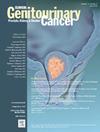Pembrolizumab治疗转移性前列腺癌微卫星不稳定患者的临床结果
IF 2.7
3区 医学
Q3 ONCOLOGY
引用次数: 0
摘要
MSI-H型前列腺癌在临床上较为少见。根据KEYNOTE-158,当它被确定时,派姆单抗是转移性去势抵抗设置的标准护理治疗选择,其中包括极少数前列腺癌患者。一些先前发表的病例系列显示,使用派姆单抗治疗的MSI-H mCRPC患者的临床结果令人鼓舞,然而,现实世界的数据仍然缺乏。在这里,我们报告了一个机构病例系列,其中13例MSI-H转移性前列腺癌患者在2019年10月至2024年12月期间接受了派姆单抗治疗,这些患者通过肿瘤组织或ctDNA的下一代测序鉴定。mccrpc 12例,mCSPC 1例。在mCRPC队列中,患者平均接受过2.7次治疗,PSA中位数为19.8 ng/mL。累及部位为淋巴结(83.3%)、骨骼(75%)、膀胱(25%)、肝脏(16.7%)和直肠(8.3%)。12例mCRPC患者中有9例(75%)在治疗期间达到PSA50,其中7例(58.3%)在PSA检测不到的情况下实现了完全生化反应。放射学上,7例经RECIST 1.1或PCWG3评估的患者的总缓解率为57.1%,其中2例完全缓解,2例部分缓解。截至数据截止,7例患者存活,2例患者仍在接受治疗。中位随访14.4个月后,中位PFS和OS均未达到。单独报道的mCSPC患者取得了完整的生化和放射学反应。在一组重度预处理的MSI-H转移性前列腺癌患者中,使用派姆单抗治疗导致了显著的生化和放射学应答率,并且多名患者实现了持久的完全缓解。分析所有患者的体细胞突变检测结果。在获得完全生化反应的7名患者中,6名患者有同源重组修复(HRR)基因突变,所有3名PTCH1突变患者都有完全生化反应,这引发了关于派姆单抗治疗的潜在预测性生物标志物的问题。报道了mCSPC患者和另一名晚期进展后再次接受派姆单抗挑战的患者的独特病例,并强调需要分别对派姆单抗在MSI-H前列腺癌中的最佳测序和持续时间进行更多研究。本文章由计算机程序翻译,如有差异,请以英文原文为准。
Clinical Outcomes of Patients With Metastatic Prostate Cancer With Microsatellite Instability Treated With Pembrolizumab
MSI-H prostate cancer is rarely encountered in clinical practice. When it is identified, pembrolizumab is a standard of care therapeutic option in the metastatic castration-resistant setting based on KEYNOTE-158, which included very few prostate cancer patients. A few previously published case series have shown encouraging clinical outcomes for patients with MSI-H mCRPC treated with pembrolizumab, however, there is still a paucity of real-world data.
Here we report an institutional case series of 13 patients with MSI-H metastatic prostate cancer identified by next generation sequencing of tumor tissue or ctDNA who were treated with pembrolizumab between October 2019 and December 2024. 12 patients had mCRPC and one patient had mCSPC. Among the mCRPC cohort, patients had received on average 2.7 prior lines of therapy and had a median PSA of 19.8 ng/mL. Sites of disease involvement were nodal (83.3%), bone (75%), bladder (25%), liver (16.7%), and rectum (8.3%).
9 of the 12 (75%) patients with mCRPC achieved PSA50 while on therapy, including 7 patients (58.3%) who achieved a complete biochemical response with undetectable PSA. Radiographically, overall response rate among the 7 patients with evaluable disease by RECIST 1.1 or PCWG3 was 57.1% with 2 complete responses and 2 partial responses. As of the data cutoff, 7 patients were alive, and 2 patients remained on treatment. After a median follow-up period of 14.4 months, median PFS and OS were not reached. The mCSPC patient, who is reported separately, achieved a complete biochemical and radiographic response.
Treatment with pembrolizumab led to a significant rate of biochemical and radiographic response in a heavily pre-treated cohort of MSI-H metastatic prostate cancer patients, and multiple patients achieved a durable complete response. Somatic mutation testing results were analyzed for all patients. Out of 7 patients who achieved a complete biochemical response, 6 had a homologous recombination repair (HRR) gene mutation, and all 3 patients with PTCH1 mutations had a complete biochemical response, raising questions regarding potential predictive biomarkers for pembrolizumab therapy. The unique cases of the patient with mCSPC and another patient who was re-challenged with pembrolizumab after late progression are reported and highlight the need for more investigation into the optimal sequencing and duration of pembrolizumab in MSI-H prostate cancer, respectively.
求助全文
通过发布文献求助,成功后即可免费获取论文全文。
去求助
来源期刊

Clinical genitourinary cancer
医学-泌尿学与肾脏学
CiteScore
5.20
自引率
6.20%
发文量
201
审稿时长
54 days
期刊介绍:
Clinical Genitourinary Cancer is a peer-reviewed journal that publishes original articles describing various aspects of clinical and translational research in genitourinary cancers. Clinical Genitourinary Cancer is devoted to articles on detection, diagnosis, prevention, and treatment of genitourinary cancers. The main emphasis is on recent scientific developments in all areas related to genitourinary malignancies. Specific areas of interest include clinical research and mechanistic approaches; drug sensitivity and resistance; gene and antisense therapy; pathology, markers, and prognostic indicators; chemoprevention strategies; multimodality therapy; and integration of various approaches.
 求助内容:
求助内容: 应助结果提醒方式:
应助结果提醒方式:


